
15 minute read
FANTASTIC TERRORS
By Jonathan Rider
The Raven, Edgar Allan Poe’s gothic poem on love lost, informs the latest cycle of gouacheand-pastel-chalk drawings by Natalie Frank, whose career-long exploration of eroticism, femininity, and power in Western literature (as wri en by men and o en projected onto women) continues to generate harrowing imagery. Created for Arion Press to accompany its publication Poe’s Phantasia, Frank gives form to the “lost” (i.e., deceased) Lenore, whose memory haunts Poe’s grief-struck narrator. Lenore’s relationship to our narrator is unknown (was she his daughter, wife, or lover?), as are the circumstances surrounding her passing. Her death, though, is an agonizing loss, so much so that her memory, in the guise or a wayward raven, drives our narrator to madness—”Take thy beak from out my heart...”1
Frank’s imagery mirrors the terror and inescapability of the narrator’s loss; but more interestingly, she illustrates Lenore, who is the object of his pain and affection but is never physically described by Poe in the poem. In Frank’s drawings, Lenore is no longer just an ideal. She is a temptress, a goddess, a blonde, a half-woman/half-bird phantasm. But foremost, she is a full-fledged participant in the narrative.
For all of its sinister intimations and technical skill2—which dovetails perfectly with Frank’s visual sensibilities—The Raven is, quite simply, an evocation of grief. It asks: What becomes of us when we lose our North Star? How deep does our grief go? Can we ever get past it?
For our narrator, reasoning away these questions with a bird, the answer is no, “nevermore.”
It’s an excruciating, claustrophobic space he has created for himself—both physically and psychologically—and one from which he won’t foreseeably escape. In the world of the poem and of Frank’s hallucinatory drawings of it, our narrator’s pain is forever fresh. To reference the poet Federico García Lorca’s “Lament for Ignacio Sánchez Mejías,”3 “The room [is] iridescent with agony.” For García Lorca, the death of a famed Spanish matador was a gravitational loss. In his poem’s first stanza, “at five in the a ernoon” is repeated nearly thirty times; it rings like a church bell to signal both Mejías’s physical death and the moment García Lorca’s world changed forever. This timeless lament remains among the most heartbreaking elegies in Western literature.
Lovers and madmen have such seething brains, Such shaping fantasies, that apprehend More than cool reason ever comprehends. The lunatic, the lover and the poet Are of imagination all compact. One sees more devils than vast hell can hold: That is, the madman. The lover, all as frantic, Sees Helen’s beauty in a brow of Egypt. The poet’s eye, in fine frenzy rolling, Doth glance from heaven to earth, from earth to heaven, And as imagination bodies forth The forms of things unknown, the poet’s pen Turns them to shapes and gives to airy nothing A local habitation and a name. Such tricks hath strong imagination, That if it would but apprehend some joy, It comprehends some bringer of that joy; Or in the night, imagining some fear, How easy is a bush supposed a bear! [I]
Poe and García Lorca couldn’t be more dissimilar in their formal approaches and tones. But their use of repetition is noteworthy, for in both cases, it underscores (like a drumbeat) the loss of the narrator. What they also share, along with so many other poets and writers who have addressed the topic of grief, is a need to question how we collect ourselves or lose ourselves in the face of loss. What does it mean to put your faith in, or define yourself through, another person? What does it mean to identify with that person so much that their absence (whatever the circumstances) feels like an existential ri ?
The room iridescent with agony at five in the a ernoon. Gangrene comes in the distance at five in the a ernoon. Trumpet of lilies on green groins at five in the a ernoon. The wounds burned like suns at five in the a ernoon, and the rabble broke the windows at five in the a ernoon. Oh, what a terrible five in the a ernoon! It was five on all the clocks. It was five in shadow of the a ernoon. [II]
Frank gives spectacular form to that ri , and in serial fashion she collapses time and space through her use of saturated colors, transparent layering of gauche and chalk pastel, exaggerated facial gestures, scale shi s, and figures that seem to materialize and/or disappear before our very eyes. In Raven I, Lenore appears as a figment of our narrator’s imagination; his larger-than-life, disembodied hand gently tips her chin upward toward a face that’s just beyond the pictorial frame. Her wide eyes project sweetness and terror—it’s impossible to ascertain her emotions. Inside her head, other memories swirl (hers? his?), and the cupped hands are either about to cradle her face or, perhaps, strangle her. In Raven III, Lenore is depicted as Pallas Athena, 1) the sculptural bust upon which the raven in the poem perches and calls out to the narrator, and 2) the Greek goddess of wisdom and warfare, and the protectress of Athens. Here, Lenore/Athena is celestial, rendered in swirling shades of cobalt blues with pin-spo ed stars shining through and around her transparent, crowned head. The raven, perched upon her shoulder, is at her command, as it calls out into the darkness. In Raven VI, Lenore merges with the bird; bare-chested, hands tousling her hair, she looks skyward, away from our morose narrator and possibly free of him.
[II] Federico García Lorca (1898-1936). Excerpt from “Lament for Ignacio Sánchez Mejías,” originally published in 1935.
The Raven’s ambiguity is mirrored in Frank’s drawings, but so, too, is the vulnerability and precarity at the core of not only this poem, but so much of Poe’s universe. Reining in that vulnerability and precarity is central to a parallel suite of seven paintings depicting female lion tamers. In these paintings, which are unrelated to a single-source text (like The Raven), Frank shi s to women seemingly in harm’s path, where both the physical and psychological threat of violence are real. And yet, her protagonists’ ardent command of a potentially perilous situation is firm.
To tame (or train) a lion is to repeat a series of physical and psychological conditioning exercises that ultimately suppress the animal’s wildness, i.e., domesticate it. Originating in the early nineteenth century as part of British and American circuses, lion taming for entertainment purposes was intended to demonstrate, in the most theatrical of circumstances, man’s mastery of the beast—his dominion over the natural world. Like bull fighters, lion tamers are performers who engage in a potentially deadly pas de deux for the consumption of spectators, who watch at a safe distance.
The world, that is, of earthquake and cataclysm, cyclone and devastation; the violent matrix, the real world of unmastered, unmasterable physical stress that is entirely inimical to man because of its indifference. [III]
Conjuring sideshow performers under harsh theatrical lighting (think Henri de ToulouseLautrec’s At the Moulin Rouge, 1892-95), Frank’s lion tamers are wide-eyed, assured, and in control of a seemingly precarious situation. The lions and Bengal tigers could, in another context, symbolize forces beyond our control, but despite the threat that a lion might pose, Frank’s depictions are of comic, lumbering, and docile creatures—more house cats than big cats. These bumbling giants are the submissives in this relationship. In The Lion Tamer I, the supplicant beast licks its heroine’s high heel; in Lion Tamer III, a lion (rendered on a scale similar to a tabletop figurine) sleeps peaceably behind its wrangler, who brandishes a whip and a diabolical stare. In Woman with Lion I, a raven-haired lion tamer embraces the big cat’s monstrous head while his exaggerated pink tongue kisses the side of her downturned face.
Daring as death and debonair
I invade my lion’s den; a rose of jeopardy flames in my hair yet I flourish my whip with a fatal flair defending my perilous wounds with a chair while the gnawings of love begin. [IV]
Power dynamics are at times ambiguous: In Lion Tamer II, Frank’s protagonist stares directly out of the pictorial frame. Her eyes, almost leaping from her head, meet ours, and it’s difficult to discern what she’s experiencing: euphoria, exasperation, fear, surprise, or relief? The harsh uplighting underscores her heightened emotional state, as do her long, shadowy eyelashes, which further frame expressive eyes that we cannot fully read. Similar ambiguities occur in Lion V. Here, a woman is sandwiched between two tigers. On the one hand, they feel domesticated, unaware of their size, and showing affection by nuzzling their mistress. On the other, they look as if they are about to switch the power dynamic and overwhelm her, with likely fatal consequences.
The Raven and Lion Tamers series explore the possibilities of losing and commanding control. Operating within tense psychological spaces—a mourner’s chamber or a ring at the center of a circus—Frank’s fantastical images both complicate and exaggerate already heightened emotional states and circumstances. In some instances, conflicting emotions exist simultaneously within the same pair of expressive but ambiguous eyes. Lenore can represent many divergent things to our narrator: She can be both the love of his life and a debilitating, haunting memory. The lion tamers can wield power and control over their animals—and what power and control that is!—but the unnatural hierarchy between the two could so easily switch. What Frank brings to light through these bodies of work is the glory and tumult, the messiness and complex vulnerability of a empting to maintain the illusion of control. In the end, though, we control absolutely nothing.
Endnotes:
1. The raven is classified as a passerine, which denotes a large order of birds distinguished by feet adapted for perching. Ravens are entirely black in their coloring, including plumage, legs, eyes, and beak (which is designed to stab its prey). An extremely intelligent bird, it has one of the widest known vocabularies of any bird species and its loud “crank,” knocking, and clucking calls are distinctive. (Northern Ireland Raptor Study Group)
2. Trochaic octameter is a poetic meter with eight trochaic metrical feet per line. Each foot has one stressed syllable followed by an unstressed syllable. This type of line—one that drops the final syllable—is called a catalectic line.
3. Ignacio Sánchez Mejías (1891-1934) was an internationally renowned matador turned playwright, novelist, essayist, airplane pilot, polo player, and race car driver; he was also a Spanish folk hero and a champion of the coterie of avant-garde artists and poets known as the Generación del 27, which included Federico García Lorca. In 1934, he was gored in the thigh during a bullfight in Manzanares, Spain. He refused medical services, contracted gangrene, and died two days later in Madrid.
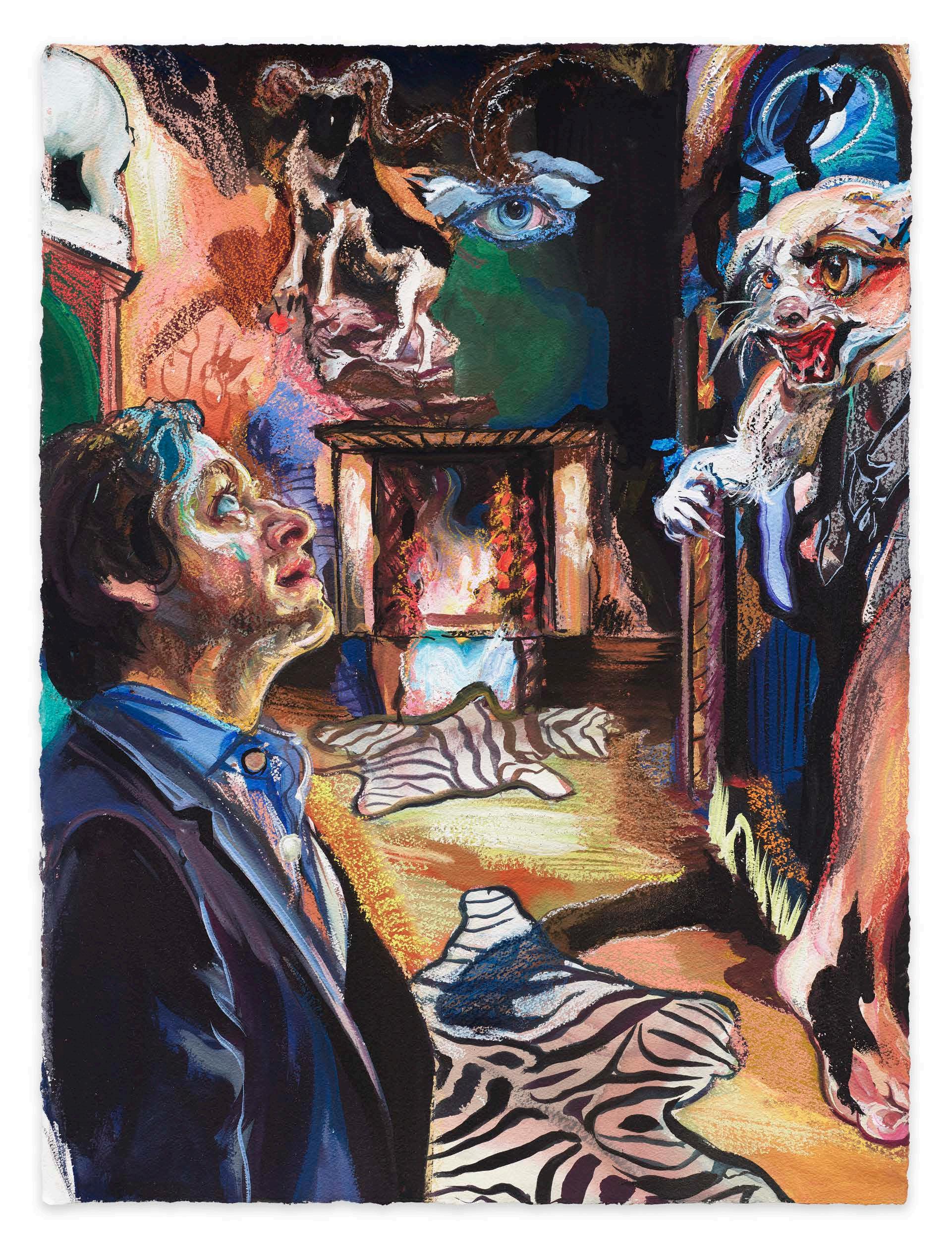

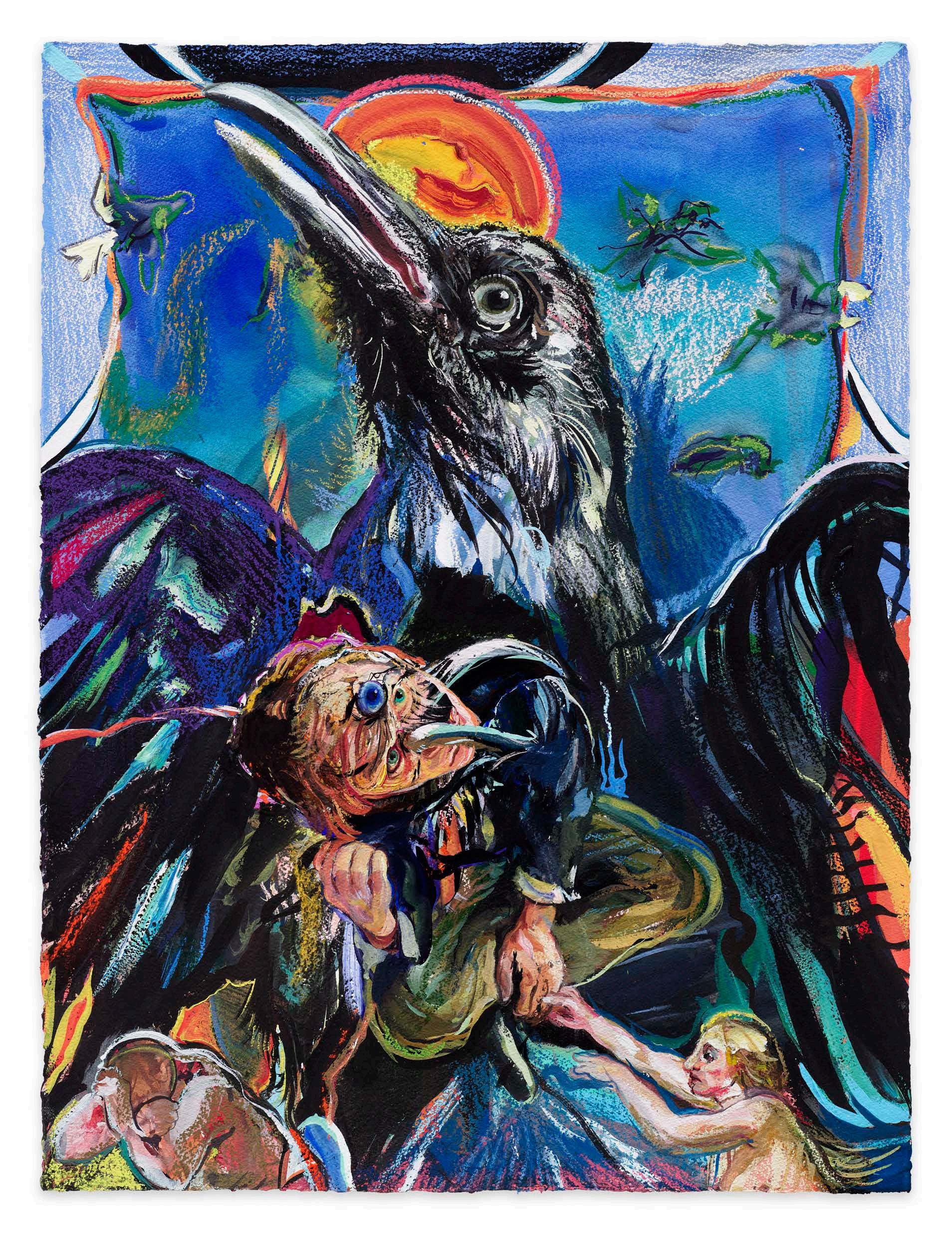
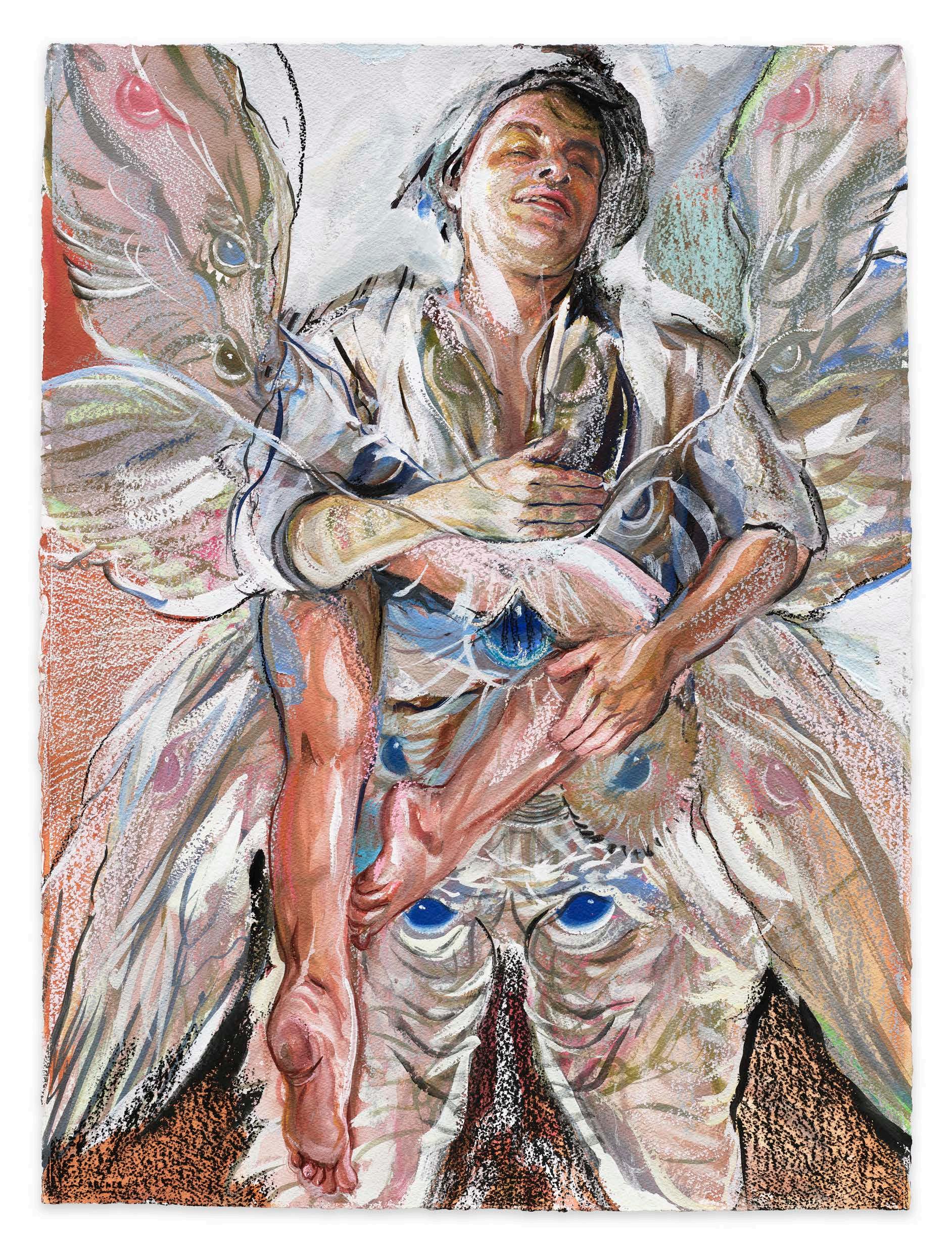
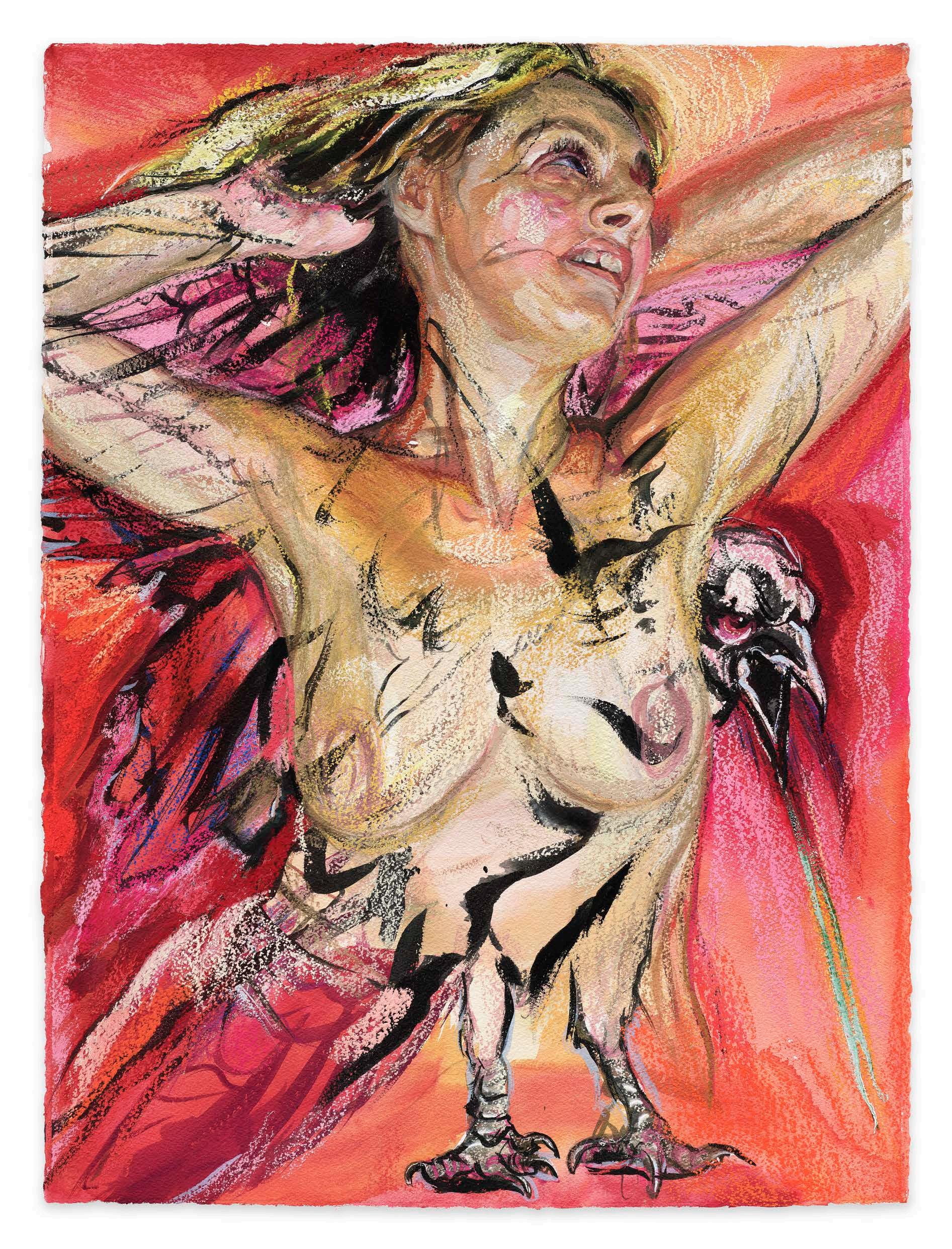

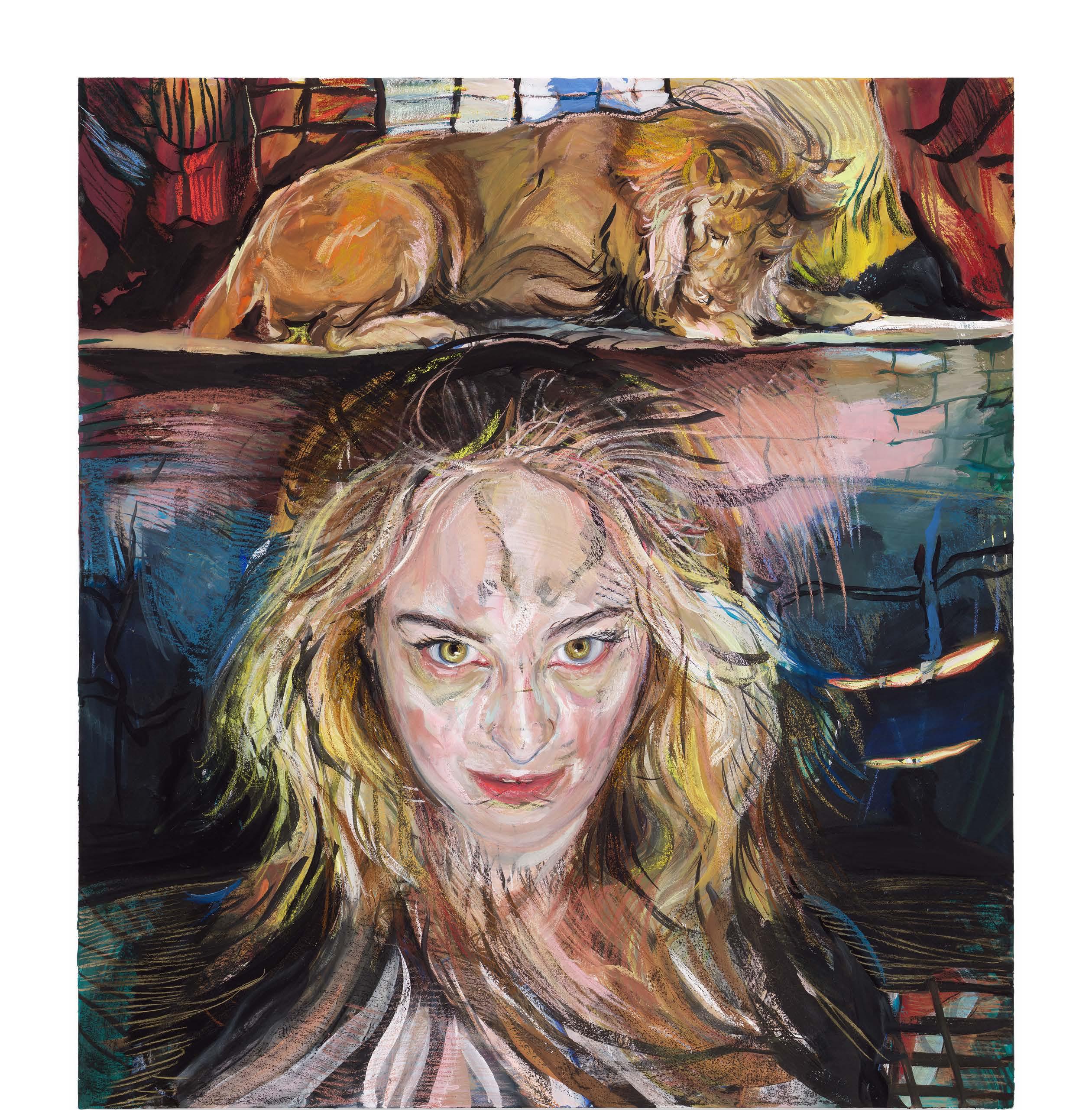



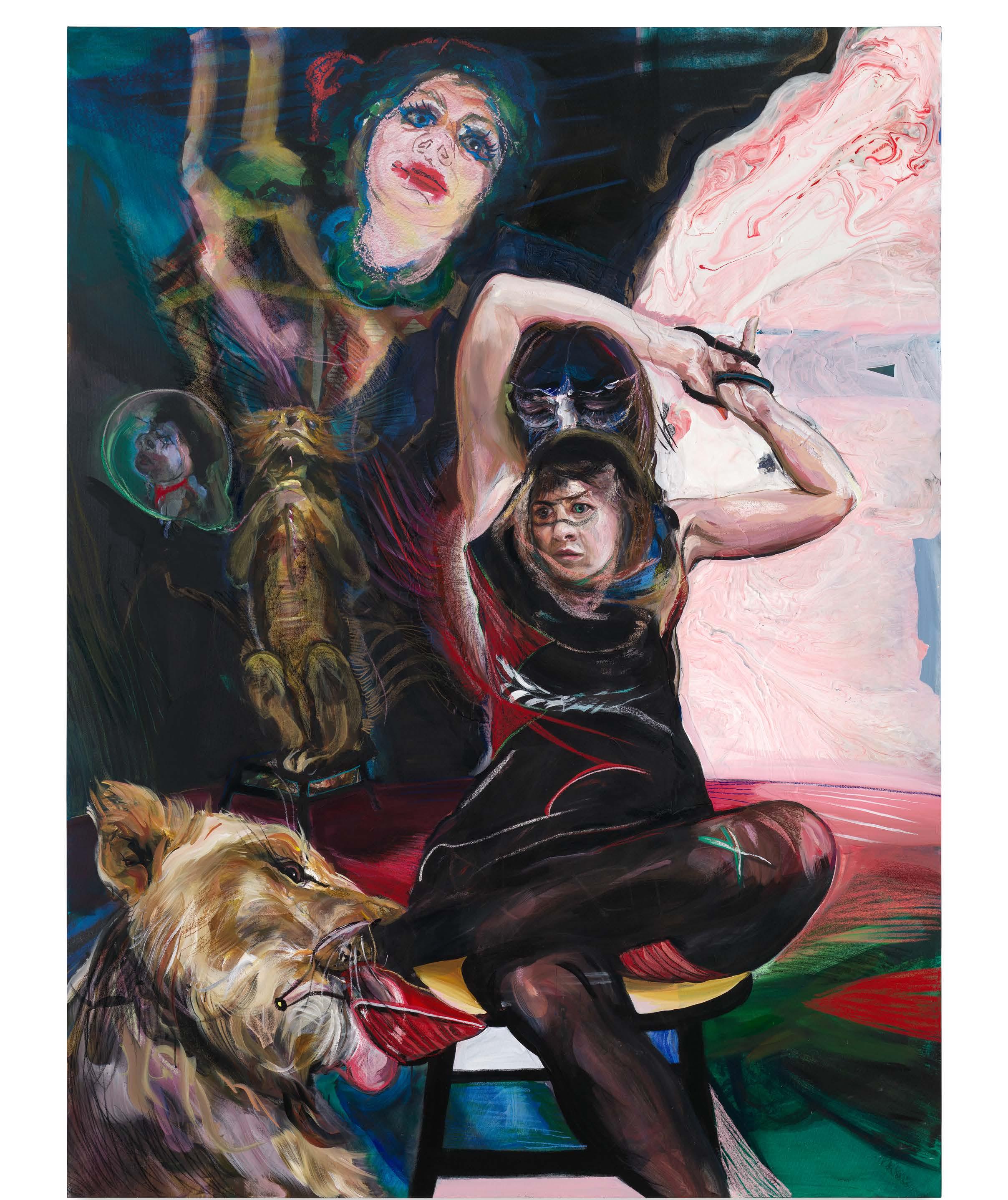




Natalie Frank
Born in 1980 in Austin, TX
Lives and works in New York, NY
Education
2006
MFA, Columbia University, New York, NY
2004
Fulbright, National Academy of Fine Art, Oslo, Norway
2002
BA, Yale University, New Haven, CT
2001
L’École Nationale Superieure des Beaux Arts, Paris, France
1999
Slade School of Art, London, United Kingdom
Solo Exhibitions
2023
“The Raven and The Lion Tamer,” Miles McEnery Gallery, New York, NY
“Companion in the Vica,” Palo Gallery, New York, NY
2022
“Natalie Frank: Unbound” (curated by Leah Kolb and Erin Dziedzic), Madison Museum of Contemporary Art, Madison, WI and Kemper Museum of Contemporary Art, Kansas City, MO
2021
“Natalie Frank: Painting with Paper,” Bra leboro Museum & Art Center, Bra leboro, VT
“Cross-Dressing for the Ba lefield,” Salon 94, New York, NY and Lyles & King, New York, NY
2020
“Don Quixote,” Half Gallery, New York, NY
2019
“GrimmTales,” Lora Reynolds Gallery, Austin, TX
2018
“O,” Half Gallery, New York, NY
2017
“Dancers and Dominas,” Rhona Hoffman Gallery, Chicago, IL
2016
“Intermission,” ACME., Los Angeles, CA
2015
“Natalie Frank: The Brothers Grimm,” The Drawing Center, New York, NY; traveled to the Blanton Museum of Art, University of Texas, Austin, TX; and the University of Kentucky Art Museum, Lexington, KY
2014
“Interiors and Openings,” Rhona Hoffman Gallery, Chicago, IL
2013
“The Scene of a Disappearance,” ACME., Los Angeles, CA
2012
“The Governed and the Governors,” Fredericks & Freiser, New York, NY
“My Noon, My Midnight, My Talk, My Song,” Space SBH, St. Barth’s Island, French West Indies
2008
“Desire Comes Later,” Arndt & Partner, Zürich, Switzerland
2007
“Where She Stops,” Mitchell-Innes & Nash, New York, NY
2006
“Unveiling,” Briggs Robinson Gallery, New York, NY
BOOKS & PERFORMANCE
2023
Poe’s Phantasia, drawings by Natalie Frank, foreword by Chris Semtner, introduction by Ed Schad, San Francisco: Arion Press.
The Wounded Storyteller: The Traumatic Tales of E. T. A. Hoffmann, drawings by Natalie Frank, foreward by Karen Russell, translations by Jack Zipes, New Haven, CT: Yale University Press.
The Crowded Room, drawings by Natalie Frank for the Apple TV Series, wri en by Akiva Goldsman, directed by Kornél Mundruczo.
2021
Jar Full of Bees, a commission of new music and film for Beth Morrison and Paola Prestini’s Liederabend Festival, animations of drawings by Natalie Frank, collaboration with Paola Prestini (composer), Eve Giglio i (soprano), Erin Pollock (artist), PBS/WNET
The Island of Happiness, Tales of Madame D’Aulnoy, drawings and preface by Natalie Frank, translations and introduction by Jack Zipes, designed by Marian Bantjes, Princeton, NJ: Princeton University Press.
2019
Grimm Tales, commission for Ballet Austin, Artistic Director: Natalie Frank, choreography by Stephen Mills, set design by George Tsypin and Natalie Frank, costume and textile design by Constance Hoffman and Natalie Frank, animations by Howard Werner and Natalie Frank, Austin, Texas, 29-31 March, Winner of 7 Critics Table Awards.
2018
O. Drawings by Natalie Frank, Sea le: Lucia Marquand Books.
2016
Zipes, Jack, ed., The Sorcerer’s Apprentice, An Anthology of Magical Tales, drawings by Natalie Frank, translations by J. Zipes, Princeton, NJ: Princeton University Press.
2015
Tales of the Brothers Grimm, drawings by Natalie Frank, essays by Claire Gilman, Linda Nochlin, Julie Taymor, and Jack Zipes,designed by Marian Bantjes, Bologna, Italy: Damiani.
Group Exhibitions
2023
“In New York, Thinking of You,” FLAG Art Foundation, New York, NY
2022
“Women Painting Women” (curated by Andrea Karnes), Modern Art Museum of Fort Worth, Fort Worth, TX
“Real Wild,” Palo Gallery, New York, NY
“Some Kind of Monster Roster,” Analog Diary, Beacon, NY
2021
“Women and Animals” (curated by Elissa Waters), Bra leboro Museum of Art, Bra leboro, VT
“On the Basis of Art: 150 Years of Women at Yale” (organized by Elizabeth Hodermarsky), Yale University Art Gallery, New Haven, CT
“Never Done: 100 Years of Women in Politics and Beyond,” Tang Teaching Museum, Saratoga Springs, NY
2020
“Sympathetic Magic,” Blum & Poe, Los Angeles, CA
“Fragmented Bodies,” Albertz Benda, New York, NY
“Eye to Eye: Untraditional Voice” (curated by John Thomson), New York Academy of Art, New York, NY
“All the women. In me. Are tired.” (curated by Jasmine Wahi), The Club, Tokyo, Japan
“Abortion is Normal” (curated by Jasmine Wahi), Galerie Eva Presenhuber, New York, NY
2019
“Stranger Approaching” (curated by Erin Leland), Bridget Donahue Gallery, New York, NY
“Paint, Porcelain and Pulp: Amy Bessone, Francesca DiMa io and Natalie Frank,” Salon 94, New York, NY
“Paper View,” The Hole, New York, NY
“Trans World,” Nicodim Gallery, Los Angeles, CA and Galeria Nicodim, Bucharest, Romania
“Go Figure!” (curated by Beth Rudin DeWoody), Eric Firestone Gallery, East Hampton, NY
“Drawn Together,” FLAG Art Foundation, New York, NY
2018
“Dread & Delight: Fairy Tales in an Anxious World” (curated by Emily Stamey), Weatherspoon Art Museum, Greensboro, NC; traveled to Faulconer Gallery, Grinnell College, Grinnell, IA; and the Akron Art Museum, Akron, OH
“Body / Parts:Works from the Collection of Raymond J. Learsy,” Ma atuck Museum,Waterbury, CT
“Paper/Print: American Hand Papermaking, 1960s to Today” (curated by Susan Gosin and Mina Takahashi), International Print Center, New York, NY
“UNSTOPPABLE” (curated by Tanya Selvaratnam for Planned Parenthood), traveling Inaugural Exhibition, Gavlak Gallery, Palm Beach, FL
“My Silences Had Not Protected Me,” For Freedoms/For Gansevoort, New York, NY
“Hot Farce,” Field Projects, New York, NY
“We Hold These Truths to be Self-Evident,” mural organized by For Freedoms, The Corcoran, Washington, D.C.
“The Un-Heroic Act: Representations of Rape in Contemporary Women’s Art in the US” (curated by Monika Fabijanska), Shiva Gallery, John Jay College for Criminal Justice, City University of New York, New York, NY
“Embodied Politic” (curated by Anastasia Tinari), Rhona Hoffman Gallery, Chicago, IL
2017
“Why Draw? 500 Years of Drawings and Watercolors,” Bowdoin College Museum of Art, Brunswick, ME
“Matisse: Selected Works from the Collection,” Montclair Museum of Art, Montclair, NJ
“Engender” (curated by Joshua Friedman), Kohn Gallery, Los Angeles, CA
“Give Voice: A Postcard Project,” LMAK books+design, New York, NY
“Gardens on Orchard,” Lesley Heller Workspace, New York, NY
“FemiNest” (curated by Heather Zises and Melinda Wang), Equity Gallery, New York, NY
“By the River,” ACME., Los Angeles, CA
“We Hold These Truths to be Self-Evident,” mural organized by New York Live Arts, Ford Foundation Live Gallery, New York, NY
2016
“Contemporary Artists Working in Paper at Dieu Donné: 2000-Present,” Wellin Museum of Art, Hamilton College, Clinton, NY; traveled to Robert C. Williams Museum of Papermaking, Georgia Institute of Technology, Atlanta, GA; and the Dedalus Foundation, New York, NY
“40 Years: Part 2,” Rhona Hoffman Gallery, Chicago, IL
“Passage,” ACME., Los Angeles, CA
“Face to Face” (with Rachel Mason), Galleria Marie-Laure Fleisch, Rome, Italy
“I am a Lie and I am Gold” (curated by Marco Breuer), Yossi Milo Gallery, New York, NY
2015
“The Artist Project, Season 1” (digital), The Metropolitan Museum of Art, New York, NY
“Dieu Donné:Workspace Program 2015,” Dieu Donné, New York, NY
“Works of Paper II,” ACME., Los Angeles, CA
“Empire of the Senseless” (curated by Thorsten Albertz), Friedman Benda, New York, NY
2014
“Stars: Contemporary Prints by Derrière L’Étoile Studio,” Zimmerli Art Museum, New Brunswick, NJ
“20th Anniversary,” ACME., Los Angeles, CA
“Sargent’s Daughters,” Sargent’s Daughters, New York, NY
“Awkward Phase,” 65 Maspeth, Brooklyn, NY
2013
“The Distaff Side,” The Granary, Sharon, CT
“Come Together: Surviving Sandy” (curated by Phong Bui), Industry City, Brooklyn, NY
“10 Under 40” (curated by Isabella Icoz), Istanbul74, Istanbul, Turkey
“Excess” (curated by Thorsten Albertz), Friedman Benda, New York, NY
“Jew York,” Zach Feuer, New York, NY
“Vivere, 13 Artists Create 13 Backdrops: Mickalene Thomas, Douglas Gordon, Teresita Fernández, Natalie Frank, Ron Gorchov, Dustin Yellin, Micheal Joo, Bosco Sodi, Ray Smith, James Siena, Douglas Gordon, Corban Walker, Adam Pendleton”
“The Golden Ass,” Blinde Arte, Naples, Italy
2012
“Designed to Win,” London Museum of Design, London, United Kingdom
“Figured Spaces: Selections from the John Morrissey Collection,” Florida Atlantic University Museum, Boca Raton, FL
“100 Li le Deaths” (curated by Tom Sanford), Bravin Lee Programs, New York, NY
“Pig Party” (curated by Gina Beavers), New York City, New York, NY
“Retrospective of S” (curated by Sam Messer and Jonathan Safran Foer), Fredericks & Freiser, New York, NY
“Kim McCarty, Natalie Frank, Alyssa Monks,” Eden Rock Gallery, St. Bart’s Island, French West Indies
“Printed Histories: 16 Years of Print Portfolios at Exit Art,” Exit Art, New York, NY
2011
“Iconomancy,” New York Academy of Art, New York, NY
“Given a Miniscule Ledge,” Norwood Club, New York, NY
“A Room of Her Own” (co-curator), Lu Magnus, New York, NY
“What the Thunder Said,” Lu Magnus, New York, NY
“Uncovered,” Eden Rock Gallery, St. Bart’s Island, French West Indies
2010
“Regarding Painting,” Rose Art Museum, Brandeis University, Waltham, MA
“Bare, Naked and Nude” (in conjunction with Bram Dijkstra, Naked: The Nude in America), Noel Baza Fine Art, San Diego, CA
“Fresh Apples,” Hezi Cohen Gallery, Tel Aviv, Israel
2009
“Reconfiguring the Body in American Art: 1820-2009,” National Academy Museum, New York, NY
“The Return of the Horse,” Slought Foundation, Philadelphia, PA
2008
“Environments and Empires,” Rose Art Museum, Brandeis University, Waltham, MA
2007
“I Like it a Li le,” V&A Gallery, New York, NY
“Aggression of Beauty II,” Arndt & Partners, Berlin, Germany
2006
“School Days,” Jack Tilton Gallery, New York, NY
AWARDS & RESIDENCIES
2021
Nominee, Joan Mitchell Fellowship, New York, NY
2020
Nominee, Anonymous Was a Woman Award, New York, NY Pollock Krasner Foundation Grant, New York, NY
2019
Dieu Donné Sponsored Grant, New York, NY
2015
Artist in Residence, Dieu Donné Workspace Program, New York, NY
2006
Dong Kingman Fellowship, Columbia University, New York, NY
2005
Elizabeth Greenshields Foundation Second Artist Grant, Quebec, Canada
Viar Merit Fellowship, Columbia University, New York, NY
2004
Fulbright Scholarship, Painting, National Academy of Fine Art, Oslo, Norway
Viar Merit Fellowship, Columbia University, New York, NY
2002
Jonathan Edwards College Arts Prize, Yale University, New Haven, CT
Sudler Grant, Yale University, New Haven, CT
2001
Elizabeth Greenshields Foundation Grant, Quebec, Canada Robert Hilgendorf Traveling Fellowship, Yale University, New Haven, CT
Sudler Grant, Yale University, New Haven, CT, Mellon Undergraduate Research Scholarship, Yale University, New Haven, CT
2000
Sudler Grant, Yale University, New Haven, CT Mellon Undergraduate Research Scholarship, Yale University, New Haven, CT
1999
Sudler Grant, Yale University, New Haven, CT
Select Collections
Ackland Art Museum, Chapel Hill, NC
Art Institute of Chicago, Chicago, IL
Blanton Museum of Art, Austin, TX
Bowdoin College Museum of Art, Brunswick, ME
Brooklyn Museum of Art, Brooklyn, NY
Beth Rudin DeWoody Collection, Palm Beach, FL
Burger Collection, Hong Kong
Everson Museum of Art, Syracuse, NY
Hall Art Foundation, Reading, VT
Kemper Art Museum, Kansas City, MO
Mills College Art Museum, Oakland, CA
Montclair Art Museum, Montclair, NJ
Pennsylvania Academy of the Fine Arts, Philadelphia, PA
Rose Art Museum, Waltham, MA
Tang Teaching Museum, Saratoga Springs, NY
Weatherspoon Art Museum, Greensboro, NC
Whitney Museum of American Art, New York, NY
Williams College Museum of Art, Williamstown, MA
Yale University Art Gallery, New Haven, CT

Published on the occasion of the exhibition
Natalie Frank
THE RAVEN AND THE LION TAMER
8 June – 22 July 2023
Miles McEnery Gallery
520 West 21st Street New York NY 10011 tel +1 212 445 0051 www.milesmcenery.com
Publication © 2023 Miles McEnery Gallery
All rights reserved
Quote © 2022 Ed Schad, with permission from Arion Press
Essay © 2023 Jonathan Rider
Director of Exhibitions
Anastasija Jevtovic, New York, NY
Publications and Archival Assistant
Julia Schlank, New York, NY
Catalogue Layout by Sean Kennedy, New York, NY
Photography by Dan Bradica, New York, NY
Farzad Owrang, New York, NY
ISBN: 978-0-9994871-4-3
Cover: Raven III (detail), 2022


